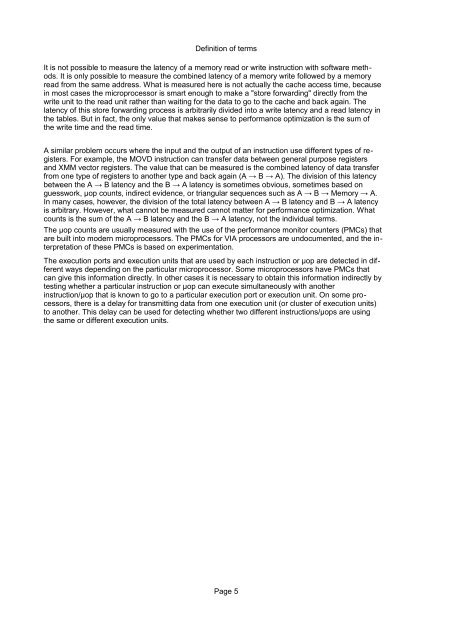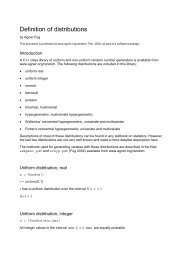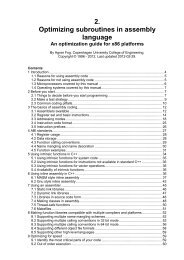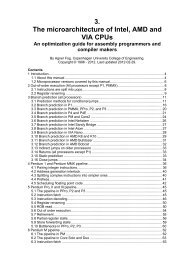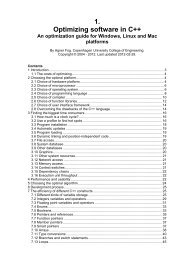4 Instruction tables - Agner Fog
4 Instruction tables - Agner Fog
4 Instruction tables - Agner Fog
Create successful ePaper yourself
Turn your PDF publications into a flip-book with our unique Google optimized e-Paper software.
Definition of terms<br />
It is not possible to measure the latency of a memory read or write instruction with software methods.<br />
It is only possible to measure the combined latency of a memory write followed by a memory<br />
read from the same address. What is measured here is not actually the cache access time, because<br />
in most cases the microprocessor is smart enough to make a "store forwarding" directly from the<br />
write unit to the read unit rather than waiting for the data to go to the cache and back again. The<br />
latency of this store forwarding process is arbitrarily divided into a write latency and a read latency in<br />
the <strong>tables</strong>. But in fact, the only value that makes sense to performance optimization is the sum of<br />
the write time and the read time.<br />
A similar problem occurs where the input and the output of an instruction use different types of registers.<br />
For example, the MOVD instruction can transfer data between general purpose registers<br />
and XMM vector registers. The value that can be measured is the combined latency of data transfer<br />
from one type of registers to another type and back again (A → B → A). The division of this latency<br />
between the A → B latency and the B → A latency is sometimes obvious, sometimes based on<br />
guesswork, µop counts, indirect evidence, or triangular sequences such as A → B → Memory → A.<br />
In many cases, however, the division of the total latency between A → B latency and B → A latency<br />
is arbitrary. However, what cannot be measured cannot matter for performance optimization. What<br />
counts is the sum of the A → B latency and the B → A latency, not the individual terms.<br />
The µop counts are usually measured with the use of the performance monitor counters (PMCs) that<br />
are built into modern microprocessors. The PMCs for VIA processors are undocumented, and the interpretation<br />
of these PMCs is based on experimentation.<br />
The execution ports and execution units that are used by each instruction or µop are detected in different<br />
ways depending on the particular microprocessor. Some microprocessors have PMCs that<br />
can give this information directly. In other cases it is necessary to obtain this information indirectly by<br />
testing whether a particular instruction or µop can execute simultaneously with another<br />
instruction/µop that is known to go to a particular execution port or execution unit. On some processors,<br />
there is a delay for transmitting data from one execution unit (or cluster of execution units)<br />
to another. This delay can be used for detecting whether two different instructions/µops are using<br />
the same or different execution units.<br />
Page 5


